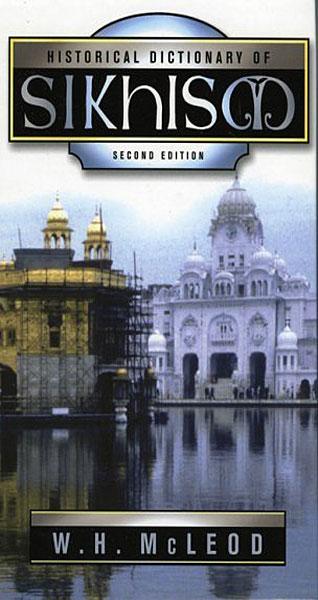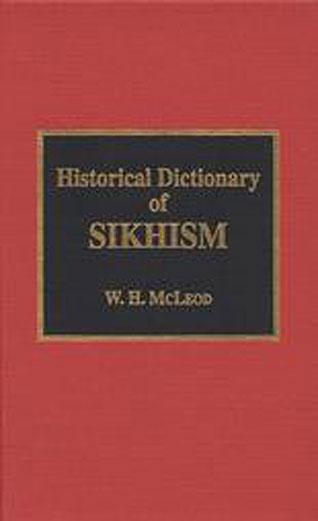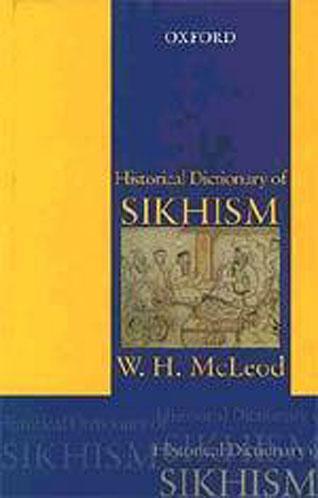Columnists
Historical Dictionary of Sikhism
A Book Review by I.J. SINGH & MANJYOT KAUR
sikhchic.com's BOOK OF THE MONTH - AUGUST 2009
HISTORICAL DICTIONARY OF SIKHISM (2nd edition) by W.H. McLeod. Scarecrow Press, Lanham, Maryland, U.S.A., 2005. ISBN 0-8108-5088-5. xxx+297 pages. Price: $70.00.
According to the most recent figures, there are over twenty-five million Sikhs, making Sikhism the fifth largest religion in the world.
Well over two million Sikhs live outside Punjab and India, with significant populations spread across six continents. North America (the United States and Canada) alone boasts over a million, while Europe, South East Asia, Australia, New Zealand and Fiji also have substantial numbers.
The numbers are relatively modest enough that much of the general public remains ignorant about their Sikh neighbors - who they are and what they believe. But these figures are also large enough, and the presence of Sikhs significant enough, to warrant increasing curiosity about "the Sikh next door."
More importantly, a new generation of young Sikhs growing up in the diaspora, far from their historical roots, requires new ways to understand and preserve their heritage. Hence the obvious need for well-written, brief, descriptive nuggets of information on all aspects of Sikh belief, culture, and lifestyle.
Perhaps the most authoritative and complete encyclopedia on Sikhism remains the Mahaan Kosh by Kahn Singh Nabha in 1930. This monumental work is wide-ranging and exhaustive; even the most arcane facts and obscure events are covered. However, it is in Punjabi, which limits its usefulness. There have been other attempts to compile shorter, more linguistically accessible encyclopediae in English, such as the ones by Harjinder Singh Dilgeer and Surinder Singh Kohli, as well as a very comprehensive four-volume Encyclopaedia of Sikhism, published by Punjabi University, India, that was the brainchild of Professor Harbans Singh.
Hew McLeod has spent a lifetime in research on Sikhism. His scholarly writings have not been free of controversy, but they have nevertheless been instrumental in defining a place for Sikhism and Sikh Studies in the consciousness of Western societies.
McLeod first published his Historical Dictionary of Sikhism in 1995. This book is a revised, much expanded second edition. It is small enough to be non-intimidating, with an inviting, user-friendly style that a wide range of readers will find appealing.
The book is divided into three main sections.
The first section begins with a map of Punjab, a "family tree" of some of the Gurus, and a chronological timeline. It then gives an abbreviated outline of the teachings of the Gurus, several paragraphs on Sikh identity, and a brief discussion of two contrasting approaches to history.
The map needs some clarification, since Punjab has been repeatedly truncated and its boundaries redrawn. In 1947, half of Punjab went into creating Pakistan; from the remaining part in India, two other states - Himachal Pardesh and Haryana - have since been carved out.
In his outline on the teachings of the Gurus, as he has done in many of his writings, once again McLeod casts Nanak as a teacher of the Sant tradition.
This erroneously diminishes the revolutionary nature of Guru Nanak's message and its enduring effect on Indian society. In this section, there is also a paragraph about the institution of the Khalsa; it fails to note that this momentous event underscored the Sikhs' sense of themselves as a separate faith that developed over two centuries from Nanak to Gobind Singh - a faith clearly demarcated by its beliefs and practices from the many Indic religions that dotted the Indian landscape.
The discussion on successors of Guru Nanak is concise by necessity. But some parts could have benefited from an extra sentence or two. For example, Guru Tegh Bahadar is described as a "recluse" who was "executed by the Mughals." The fact that he accepted death in support of the rights of a people of another faith is highly significant and rated at least a few words.
Guru Gobind Singh is portrayed as "the leader of his Sikhs, fighting to sustain his position as the ruler of a small Shivalik principality"! This makes him seem like some petty warlord instead of a Guru! His four sons were martyrs to the cause, but McLeod's description sounds as if the older two sons were killed running away instead of defending Chamkaur in battle.
It would have also been appropriate to add that the younger two sons, even as small children seven and eight years old, were willing to be martyred rather than accept Islam.
A continuously held and deeply loved belief that permeates Sikhism is that in 1699, five Sikhs (Panj Piarey) were the first to accept initiation in the Khalsa, and that Guru Gobind Singh himself accepted initiation from their hands.
Hew McLeod elides by this very significant point. It is as if in a presentation on Christianity, one were to ignore the detail of crucifixion because not all the facts may be historically clear.
A fundamental doctrine in Sikhism is the connectedness and continuity of the message from Guru Nanak to Guru Gobind Singh. Somehow this linkage does not clearly come through in McLeod's exposition of the Sikh faith.
McLeod then steps into an area that has proved so difficult for him in the past. His emphasis on "traditional" historian vs. "skeptical" historian is disconcerting.
His ideas of "tradition" are completely suffused with a sense of his head-shaking doubt. It is as if believers of a faith - "traditional" interpreters - are incapable of intellectual rigor when looking at their own faith.
The best that can be done is to give them "a measure of cautious trust"?
The "skeptical" ones are the only ones who "investigate"?
Although he ends his section with the proviso, "History is constantly being rewritten and no interpretation is forever fixed," he states that "this historical dictionary adopts the contrary view," i.e., tradition is not generally reliable. Many entries in this book seem to be colored by this attitude.
We would argue that an inherent conflict between intellectual rigor and faith does not exist. One can honestly believe and yet question whatever in a tradition may be only inadequately documented. An unbiased scholar can and should just as easily start with the assumption that the unbroken continuity of a tradition speaks generally to its veracity, unless incontrovertible evidence is found to debunk it.
Like a giant glossary, the second section of the book covers the gamut of topics on Sikh religion, history, and culture. Many entries stand out for the brief, but complete, treatment of their subject. For instance, the ones on "Gender" and "Gender of God" are excellent and terse commentaries on the unequivocal Sikh ideal of gender equality, and the actual practice that varies considerably from it.
Another example of this is "Sikh Architecture," a short, but tantalizing note on its distinctive style.
The development and sentiment for a Sikh "Nanakshahi" calendar finds well-deserved space.
Other entries are, perhaps, somewhat less adequately presented. One of these is the entry on "Art." It talks about the popular genre of calendar illustration, and mentions the artists Sobha Singh and Kirpal Singh. However, there is little analysis or discussion of other influences on Sikh art, or the course of its development.
McLeod's 1991 book, Popular Sikh Art, albeit a work of much greater specificity, provides a far more useful introduction to this topic.
Among famous Sikhs, Giani Zail Singh, the president of India in 1984 when the Indian Army attacked the Golden Temple, rates inclusion, as does another major personage of this period, Sant Jarnail Singh Bhindranwale. But the entries on both are much too skimpy; they whet the appetite, but do not satisfy.
Sirdar Kapur Singh is dismissed in one sentence by a mention of his participation in the agitation for Punjabi Suba and Khalistan. His role as the major architect of the Anandpur Sahib Resolution, as well as his significant analytic contributions to the exposition of a uniquely Sikh worldview, are neglected.
One accurate measure of the importance of a historical event is the extent of the resulting consequences. For this reason, the Anandpur Sahib Resolution deserved a more complete treatment. The Indian government repeatedly blamed this resolution as the root of the troubling events of the two decades that brought the country to the brink of fragmentation in the 1980s.
The five articles of Sikh faith (panj kakkars) that all Amritdhari and many Keshadhari Sikhs wear are defined. However, the entry notes that perhaps there were only three - kesh, kirpan and kacchera (long, unshorn hair, sword, and knee-length breeches) - that were mandated on the historic Vaisakhi of 1699 at the inauguration of the Khalsa. McLeod suggests that the other two appeared later. Most Sikhs would find this interpretation difficult to accept.
There is considerable dissension about the exact authorship of the writings ascribed to Guru Gobind Singh. The Sikh Panth has accepted some to be authentic, but the larger body of writing in the Dasam Granth appears to have been penned by other poets of that era.
McLeod accepts this view and handles the disagreements with great aplomb. This dispute, however, continues to fester. Based on his critical analysis of the contents of Dasam Granth and his similar treatment of a hagiographic work, Gurbilas Patshai Chheveen, Gurbakhsh Singh Kala Afghana has been excommunicated by the Jathedar Akaal Takht.
Even though controversial, Kala Afghana's writings have electrified a whole generation of Sikhs; yet, McLeod has not mentioned him or his works, either in his text or in his bibliography, perhaps because he has written only in Punjabi.
This is an unfortunate omission in what is otherwise a very inclusive work.
The third and final section comprises over one hundred pages of bibliography and source materials, with its own very useful "Contents" listing, compiled by subject headings. Librarians would find this approach extremely valuable when organizing their collections on Sikhism. This is a superb and extensive collation, ranging from the traditional hagiographies known as janam-sakhis, to more intellectually rigorous scholarly works. McLeod even provides references to publications that have been sharply critical of his own writings.
There is also a listing of the plethora of websites on Sikhism that have appeared, particularly in the diaspora, over the past two decades. These offer a whole gamut of topics, ranging from forums of opinion and debate to search engines and translations of Guru Granth Sahib, as well as other texts. However, McLeod has omitted listing websites such as the Sikh American Legal Defense and Education Fund (SALDEF), formerly known as the Sikh Mediawatch and Research Task Force (SMART), as well as the Sikh Coalition.
These sites deserve inclusion on the basis of their unparalleled activity and assistance in matters of equal rights in our complex North American existence.
Subject to the caveats mentioned above, this nevertheless remains a very valuable book that will be of undeniable appeal to a broad audience. It is strongly recommended as an addition to gurdwara, academic and public library collections.
Its style is terse, but very readable, as befits a work of this genre. Its wealth of useful facts and cross-references will undoubtedly serve as a springboard to motivate the reader towards more in-depth exploration and research.
Scarecrow Press has sponsored a unique series of publications under the aegis of its editor, Jon Woronoff. It has published a range of notable historical accounts of most major world religions, including not only Sikhism, but also Catholicism, Ecumenical Christianity, Hinduism, Islam, Judaism, Taoism and the Baha'i faith. It has also put out accounts of philosophies and movements whose ideas have served to shape humankind, such as the Civil Rights Movement, the Gay Liberation Movement, Organized Labor, the Welfare State, the Olympic Movement, and many others.
This book by Hew McLeod is a worthy addition to this excellent series by Scarecrow Press.
July 31, 2009
Conversation about this article
1: Gurjender Singh (Maryland, U.S.A.), August 01, 2009, 8:12 PM.
As Dr. I.J. Singh refers to Hew McLeod's description of Guru Tegh Bahadar as a "recluse" who was "executed by the Mughals." And that his acceptance of death in support of the rights of a people of another faith is highly significant and rated at least a few words. And so did the sacrifice of Guru Gobind Singh and his four children. I believe that the main reason for these errors lies at our doorstep, because Hew was not born Sikh and most of our history books, including Mughal history, which are being used in schools and college do not mention these facts. As Sikhs, we failed to teach the world about this major and important part of part of history. Even the movies related to the Mughal era do not even mention these facts. Most of our history remains within the walls of our gurdwaras and our own children are losing track of it. Sikh leadership needs to preserve this history by out-reaching others during Gurpurab celebrations and nagar kirtans.






